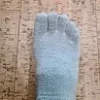Immediately* after first sensing a hot spot, I take off my boot and sock, let my foot air dry for several minutes, and then apply any type of slippery tape** to the full bottom of my foot (behind the toes) and around the heel curve and about 10 cm up the heel to just under the top of my sock, so that it remains invisible to sniggering bystanders. When applying the tape, I bend my foot upwards as far as possible to stretch the skin at the heel. This ensures that the tape will not be under tension at the heel. After the foot un-flexes, the tape wrinkles a bit at the heel but that does not matter as long as the tape is firmly adhered to the dry skin.
*In my experience, one must take action immediately after sensing a hot spot. Walking e.g. 5 additional paces in the forlorn hope that the hot spot will go away on its own is not advisable: the hot spot indicates immediately-impending skin de-lamination and blister formation. Stop walking right away.
** The purpose of the tape is to facilitate sliding movement between the sock and the tape, and to prevent shear forces from arising between the layers of skin.
After applying the tape, I never attempt to remove it until it peels off by itself in the shower. Of course I carefully wash my feet with hot soapy every time I shower, and dry them carefully, but I do not interfere with the tape. No testing to see if it is ready to come off.
It can take several days of hiking for the spontaneous-self-removal-in-shower of the tape to occur. The tape is a bit tattered and grubby by then. Disgusting? Maybe, but my feet have not complained.
When the tape does fall off in the shower, of course I carefully wash and dry the newly-exposed skin. There are usually a few stripes of adhesive left on the skin. I just leave them alone. The newly-exposed skin always looks healthy and glowing after its few days of vacation from friction.
I have tried all sorts of tapes including moleskin, surgical paper tape, duct tape, clear polyester cardboard-box-sealing tape, etc. My practical field experiments have convinced me that:
- my feet cannot read the brand names or prices marked on the rolls of tape; they are down-to-earth fellows and do not care about marketing hype; and,
- the tape adhesive must be sufficiently sticky to reliably prevent any movement between the tape and the skin; and,
- the outer surface of the tape must be slippery so that there is no friction between tape and sock. This reduces the shear stress between tape and foot, and helps to prevent de-lamination between skin layers.
I have had great success with both 3M clear polyester cardboard-box-sealing tape, and with duct tape. Polyester cardboard-box-sealing-tape is more slippery on the outside and I would prefer it except that it is difficult to find and grasp the end of the tape on the roll, and difficult to tear off a length without using some sharp tool. In my experience, duct tape is easier to unwrap from its roll in the field, and easier to tear off from its roll.
I keep a supply of my favourite tape rolled up on each walking stick, just under the hand grips where it is out of the way, but can be accessed immediately after sensing a hot spot, without needing to fuss about with my pack.
Of course one need not wait for a hot spot: just apply the tape on the first morning before starting to walk.




























